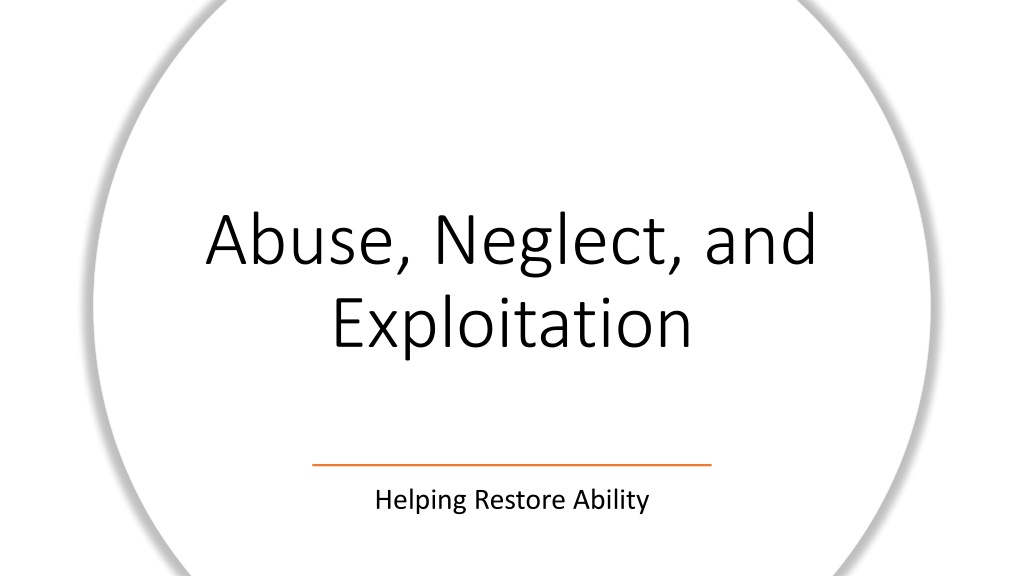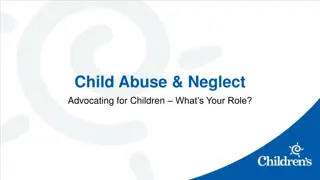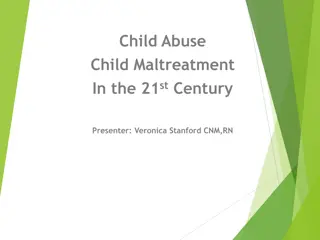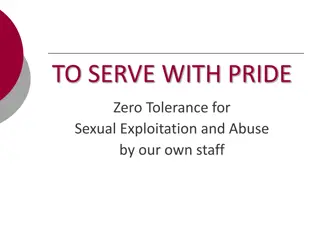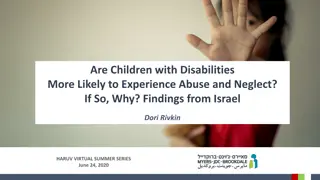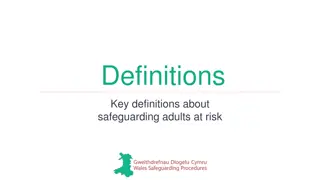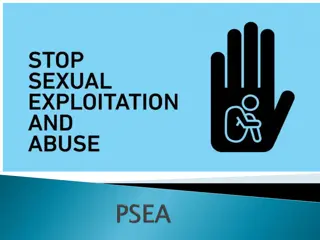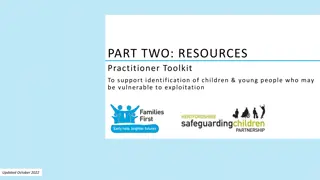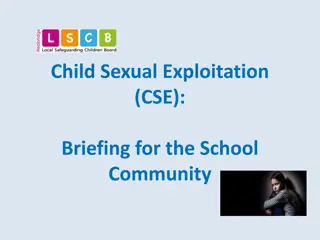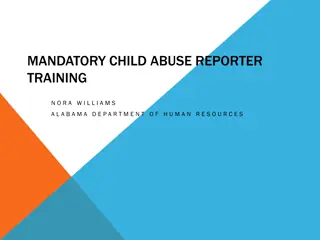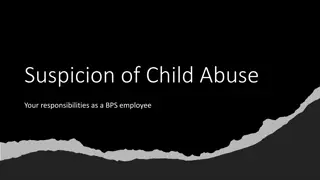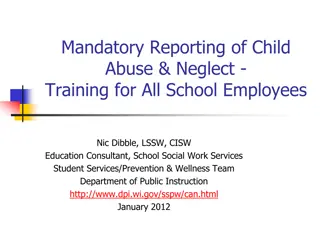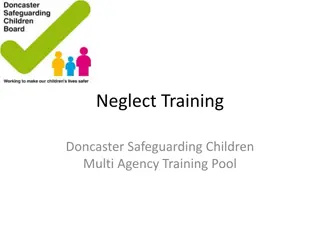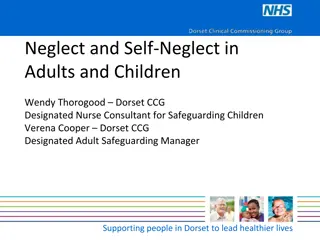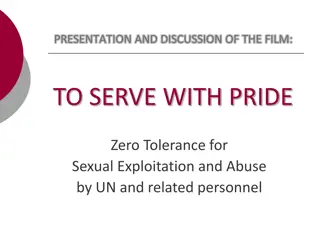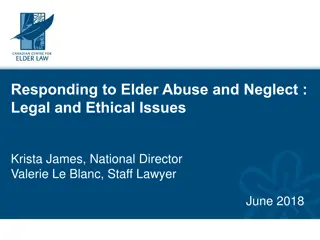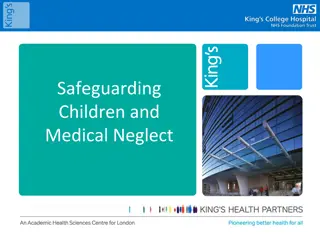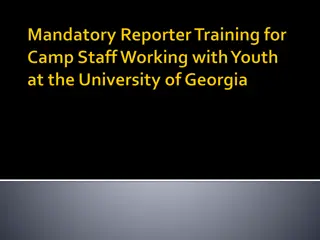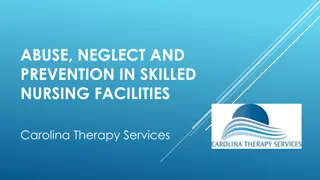Understanding Abuse, Neglect, and Exploitation: Course Overview
This course provides valuable insights into recognizing and addressing abuse, neglect, and exploitation, particularly concerning vulnerable populations such as the elderly and disabled. It covers identifying signs, understanding responsibilities, and taking action to prevent harm. The content emphasizes the importance of education and intervention in combating these serious issues.
Download Presentation

Please find below an Image/Link to download the presentation.
The content on the website is provided AS IS for your information and personal use only. It may not be sold, licensed, or shared on other websites without obtaining consent from the author. Download presentation by click this link. If you encounter any issues during the download, it is possible that the publisher has removed the file from their server.
E N D
Presentation Transcript
Abuse, Neglect, and Exploitation Helping Restore Ability
In this course we will go over what abuse, neglect, and exploitation look like and how to address these issues Course Description
Care Team Manager HR Manager Contact Information Office Phone: 817-823-6759 Office Hours: Mon-Thurs. 8-5 Friday 8-4
https://learningportal.hhs.texas. gov/course/view.php?id=311 This link is for the Texas health and Human Services Commission online training on abuse neglect and exploitation. This is required of all attendants to complete within 2 weeks of orientation To access online training manually- Required Trainings 1. https://learningportal.hhs.tex as.gov/course/view.php?id=3 11 2. Select "Health and Human Services Commission Courses" 3. Select "ANE Competency Training and Exam (online)" 4. Register as a user to take the course, "create new account" Send completion of course to supervisor so it can be put in your file. 5. You must receive a score of at least 80% for completion of the quiz
Books HRA Policies/Procedures Handbook Websites https://www.tcsheriff.org/images/victim- services/docs/crimes_against_disabled_and_elderly.pdf https://ncea.acl.gov/NCEA/media/docs/Abuse-of-Adults-with-a- Disability-(2012).pdf https://www.helpguide.org/articles/abuse/elder-abuse-and- neglect.htm Materials Videos https://www.youtube.com/watch?v=OEGhbbpel30
Course Objectives Course Objectives Skills Developed 1-What is abuse? Know what abuse/elderly abuse looks like 2-Signs of abuse Be able to identify signs of abuse 3-What is Neglect? Know what neglect means 4-What is exploitation? Know what exploitation looks like Know your responsibility if suspected neglect, exploitation or abuse occur 5-Our responsibility
Section 1- Abuse Abuse is the physical, sexual verbal or emotional injury to a person or failure to prevent such injury. Elderly and disabled persons are more vulnerable to become victims of abuse because of their dependence on others for care. According to the NCEA (National Center on Elderly Abuse), "30% of adults with disabilities, who used ADS for support of activities of daily living, reported one or more types of mistreatment (i.e. physical abuse, verbal abuse, financial abuse) by their primary provider." It's our job to begin changing this heartbreaking statistic!
What makes this abuse so complex? Some diseases and chronic illnesses can mask/mimic the visible signs of abuse e.g., certain medications, diseases causing easy bruising No single characteristic identifies an abuser Abuse is often subtle, especially when it is pre- meditated. Abuse can also be spontaneous Often the victims and abusers will attempt to hide the abuse
Types of abuse Physical abuse- Non-accidental use of bodily force that results in physical pain, injury, or death e.g., physical restraining, force-feeding, hitting, shaking, kicking, etc. Verbal or Emotional abuse- Treatment in a way that causes psychological pain or distress e.g., intimidation by yelling or threats, withholding attention, isolating client from the outside world, humiliation or ridicule, etc. Sexual abuse- any sexual contact without consent or sexual activities with someone who is unable to give consent Abandonment- deserting of a person in a public place or other location with no intention of returning for them or finding alternative care
Why does abuse happen? (contributing factors) Mental illness Drug addiction Alcoholism Financial stress Caregiver stress Lack of proper caregiver skills/training Family history of violence If you ever feel as though the situation is becoming too stressful, contact your supervisor immediately so proper arrangements of care can be made.
Section 2- Signs of abuse Sudden changes in the individual (depression, withdrawn) Fear or agitation Physical signs may include Bruising, welts (commonly on back/stomach areas), broken bones, rope marks, vaginal, anal bleeding Underclothes are torn, stained/bloody https://www.youtube.com/watch?v=OEGhbbpel30
Section 3- Neglect Neglect is when the person who assumes responsibility for providing necessary care (attendant) to a client, refuses or otherwise fails to do so. e.g., Task list- cleaning, grooming, meal preparation, medication assistance, etc. ; failing to do these tasks for your client knowingly is neglecting your obligation as their caregiver. Self-neglect is when the person taking care of themselves does so in a way that jeopardizes health and well-being
Signs of Neglect UNTREATED BEDSORES UNSANITARY LIVING CONDITIONS FLEAS, BEDBUGS, LICE FECAL/URINE ODORS POOR HYGIENE DEHYDRATIONS UNSAFE LIVING CONDITIONS
Section 4- Exploitation Exploitation is when someone who has a relationship with the client (caregiver, family member) misuses the person's resources for person or monetary benefits. e.g., taking/misusing clients personal checks, credit cards, ATM cards, social security card, food stamps etc., theft of jewelry, property, money
Signs of Exploitation UNEXPLAINED/SUDDEN INABILITY TO PAY BILLS OVERDUE RENT UTILITIES TURNED OFF DISAPPEARANCE OF PERSONAL PROPERTY CHANGES IN WILL, POWER OF ATTORNEY OR PAYEE CLIENT SIGNING PAPERS THEY DON T UNDERSTAND EXCESSIVE PAYMENT FOR CARE/SERVICES UNHEALTHY RELATIONSHIP
It is mandatory for us, as an agency, to report all concerns of suspected abuse, neglect and exploitation according to Texas guidelines It is your responsibility as a caregiver to report suspected abuse, neglect or exploitation within 24 hr. of discovering Immediately to Care Team Manager(817-823- 6759) Texas Department of Family and Protective Services (TDFPS) at (1-800-252-5400) or at their secure website (www.dfps.state.tx.us/Contact_Us/report_abuse .asp) Texas Department of Aging and Disability Services (DADS) at (1-800-458-9858) Our Responsibility
